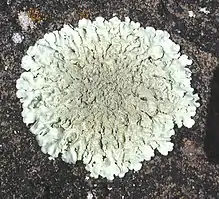Squamulose lichen
A squamulose lichen is a lichen that is composed of small, often overlapping "scales" called squamules.[1] If they are raised from the substrate and appear leafy, the lichen may appear to be a foliose lichen, but the underside does not have a "skin" (cortex), as foliose lichens do. [2] Squamulose lichens are composed of flattish units that are usually tightly clustered. They are like an intermediate between crustose and foliose lichens.

A squamulose lichen growing on basalt
Examples of squamulose lichen include Vahliella leucophaea, Cladonia subcervicornis and Lichenomphalia hudsoniana.[3]
References
- Dobson, F.S. (2011). Lichens, an illustrated guide to the British and Irish species. Slough, England: Richmond Publishing Co. Ltd. ISBN 9780855463151.
- "Morphology of Lichens". www.ucmp.berkeley.edu. Retrieved 20 December 2022.
- "FAQs". Images of British Lichens. Retrieved 3 April 2020.
This article is issued from Wikipedia. The text is licensed under Creative Commons - Attribution - Sharealike. Additional terms may apply for the media files.